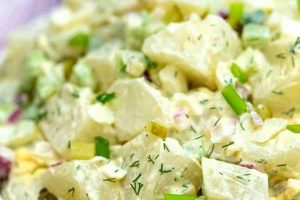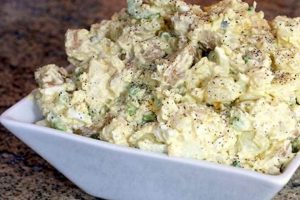Ina Garten, widely known as the Barefoot Contessa, has popularized specific approaches to potato salad, often featuring unique ingredient combinations and techniques. These typically emphasize fresh, high-quality ingredients and simple yet elegant preparations. Examples include her Classic Potato Salad with celery, red onion, and a tangy mayonnaise dressing, and her Creamy Potato Salad with fresh dill and chives.
Garten’s versions often depart from traditional recipes, offering sophisticated flavor profiles appealing to a broad audience. Her influence stems from her approachable cooking style, emphasizing ease of preparation and delicious results. This has led to a renewed interest in homemade potato salad and elevated its status beyond a simple picnic side dish. Her recipes contribute to a larger culinary trend focusing on fresh, seasonal ingredients and simple techniques that allow the natural flavors to shine.
Further exploration of specific variations and the underlying principles behind these recipes can provide a deeper understanding of their appeal and contribute to a richer appreciation of Garten’s culinary approach. Examining ingredient choices, preparation methods, and serving suggestions offers valuable insights into creating delicious and memorable potato salads.
Tips for Elevated Potato Salad
Achieving superior potato salad involves attention to detail throughout the preparation process. These tips offer guidance on ingredient selection, cooking techniques, and flavor balancing.
Tip 1: Potato Selection: Opting for waxy potatoes, such as Yukon Gold or red-skinned varieties, ensures they hold their shape after cooking and contributes to a creamy texture. Russet potatoes, being higher in starch, tend to become mealy and are less suitable.
Tip 2: Proper Cooking: Potatoes should be cooked until tender but not mushy. Overcooked potatoes absorb excessive water and compromise the salad’s texture. Starting potatoes in cold, salted water and avoiding rapid boiling promotes even cooking.
Tip 3: Timely Dressing: Dressing the potatoes while still warm allows them to absorb the flavors more effectively. However, ensure they have cooled slightly to prevent the mayonnaise from separating.
Tip 4: Flavor Balancing: A balanced flavor profile incorporates acidity, sweetness, and savory elements. Tangy ingredients like vinegar or pickles complement the richness of the mayonnaise, while a touch of sweetness from sugar or chopped onions adds complexity.
Tip 5: Fresh Herbs: Incorporating fresh herbs elevates the flavor profile. Dill, chives, parsley, or tarragon provide bright notes that enhance the overall taste and visual appeal.
Tip 6: Ingredient Quality: Using high-quality mayonnaise and fresh, crisp vegetables enhances the salad’s overall quality. Homemade mayonnaise or a premium store-bought version is recommended.
Tip 7: Chilling Time: Allowing the potato salad to chill for at least an hour, preferably longer, allows the flavors to meld and deepen. This also improves the texture, as the potatoes firm up upon cooling.
By following these guidelines, one can achieve a potato salad that is not only visually appealing but also offers a harmonious balance of flavors and textures.
These tips, combined with an understanding of the foundational elements, contribute to creating a truly exceptional potato salad.
1. High-quality Ingredients
Ina Garten’s emphasis on high-quality ingredients is fundamental to the success of her potato salad recipes. Ingredient quality directly impacts the final dish’s flavor, texture, and overall appeal. This section explores the significance of selecting premium components.
- Fresh Produce:
Garten prioritizes fresh, seasonal produce. Using freshly dug potatoes, recently harvested celery, and vibrant onions contributes significantly to the potato salad’s vibrancy. Freshness ensures optimal flavor and texture, crucial for a dish where the ingredients’ natural tastes are prominent. The difference between freshly picked herbs and dried counterparts is readily apparent in the final product.
- Mayonnaise Selection:
Mayonnaise serves as the foundation of many potato salad dressings. Opting for high-quality mayonnaise, whether homemade or a premium store-bought brand, dramatically impacts the salad’s richness and overall flavor profile. The quality of oils and eggs used in mayonnaise production significantly affects its taste and texture.
- Vinegar and Acidic Elements:
The inclusion of vinegar or other acidic elements provides balance and brightness. Using quality vinegars, such as apple cider vinegar or white wine vinegar, contributes nuanced flavors. Freshly squeezed lemon juice offers another dimension of acidity and freshness. The correct balance of acid prevents the salad from becoming overly rich or bland.
- Herbs and Spices:
Fresh herbs play a critical role in Garten’s potato salads, adding depth and complexity. Fresh dill, chives, parsley, or tarragon elevate the flavor profile beyond basic seasonings. Using high-quality spices, like freshly ground black pepper, further enhances the overall taste experience. The aromatic oils in fresh herbs and spices contribute significantly to the final dish’s sensory appeal.
The cumulative effect of using top-tier ingredients elevates Garten’s potato salads from simple side dishes to memorable culinary experiences. The interplay of fresh produce, quality condiments, and aromatic herbs results in a harmonious blend of flavors and textures, showcasing the importance of ingredient selection in achieving culinary excellence.
2. Simple Preparation Methods
Simplicity in preparation is a hallmark of Barefoot Contessa recipes, including potato salad. This approach emphasizes the inherent flavors of fresh, high-quality ingredients without relying on complex techniques or elaborate procedures. The ease of preparation makes these recipes accessible to a wide range of cooking skill levels, promoting home cooking and enjoyment of quality food without extensive culinary expertise. This straightforwardness contributes to the recipes’ popularity, demonstrating that delicious, sophisticated dishes can be achieved without complicated methods. For instance, Garten’s Classic Potato Salad recipe involves boiling potatoes, chopping vegetables, and combining them with a simple dressing. The focus remains on the quality of ingredients and their harmonious combination rather than intricate culinary maneuvers.
The connection between simple preparation and the final product lies in the preservation of ingredient integrity. Overly complex procedures can mask the natural flavors of fresh produce. Garten’s streamlined methods allow the inherent flavors of the potatoes, celery, onions, and herbs to shine through. This directness contributes to the clean, bright flavor profiles characteristic of her potato salads. Furthermore, the simplicity encourages experimentation with variations, allowing cooks to adapt recipes to their preferences and available seasonal ingredients. One might substitute different herbs, add a touch of mustard to the dressing, or incorporate other vegetables while maintaining the fundamental ease of preparation.
Ultimately, the emphasis on simple preparation methods underscores the accessibility and appeal of Barefoot Contessa potato salad recipes. This approach democratizes gourmet cooking, demonstrating that delicious and elegant dishes can be achieved without demanding techniques. The focus on quality ingredients and straightforward procedures allows home cooks to create impressive potato salads that showcase fresh flavors and textures. This contributes to a broader culinary trend of appreciating simplicity and highlighting the inherent qualities of good food.
3. Balanced Flavor Profiles
Balanced flavor profiles are central to Ina Garten’s potato salad recipes, distinguishing them from simpler versions. These recipes achieve complexity and depth through the careful interplay of contrasting yet complementary tastes. Acidity, sweetness, saltiness, and savory elements are combined strategically, preventing any single flavor from dominating. This balanced approach elevates the dish beyond a basic side, offering a more nuanced and satisfying culinary experience.
Acidity, often derived from vinegar or lemon juice, provides brightness and cuts through the richness of the mayonnaise. Sweetness, sometimes introduced through a touch of sugar or the subtle sweetness of chopped onions, balances the tanginess. Salt enhances the other flavors and provides a foundational savory element. Further savory notes are introduced through ingredients like celery, herbs, and sometimes mustard. Garten’s Classic Potato Salad exemplifies this balance, featuring tangy mayonnaise dressing, the slight sweetness of red onion, the savory notes of celery, and the freshness of herbs.
The practical significance of this balanced approach lies in its impact on palatability and enjoyment. A dish with a balanced flavor profile is more likely to appeal to a broader range of tastes. It offers a complexity that keeps the palate engaged, preventing the experience from becoming monotonous. The interplay of contrasting flavors creates a dynamic sensory experience that enhances appreciation for the individual components and their combined effect. Understanding this principle allows for informed adjustments and adaptations. Cooks can tailor recipes to individual preferences by fine-tuning the balance of acidity, sweetness, and savory elements, demonstrating an understanding of the underlying principles that guide flavor development in Garten’s recipes.
4. Fresh Herbs Prominence
Fresh herbs constitute a signature element of Barefoot Contessa potato salad recipes, distinguishing them from more traditional preparations. Their prominence contributes significantly to the overall flavor profile, adding brightness, complexity, and a fresh, vibrant character. Unlike dried herbs, which can impart a muted, sometimes bitter taste, fresh herbs offer a nuanced and aromatic dimension. This emphasis on fresh herbs aligns with Ina Garten’s broader culinary philosophy, which prioritizes fresh, high-quality ingredients and allows their natural flavors to shine.
Specific examples illustrate this principle. Garten’s Classic Potato Salad often features fresh dill, which imparts a subtle anise-like flavor that complements the other ingredients. Chives, with their delicate oniony flavor, provide another layer of complexity. Parsley, while more subtle, contributes a fresh, clean note. The choice of herbs can be adapted based on personal preference and seasonal availability, offering opportunities for customization while maintaining the emphasis on freshness. The quantity of herbs used is also significant. Garten often incorporates generous amounts, ensuring their flavor is noticeable without overpowering the other components. This contributes to a multi-dimensional flavor profile that evolves with each bite.
The practical significance of understanding the role of fresh herbs lies in the ability to replicate and adapt these recipes successfully. Using fresh, high-quality herbs is crucial for achieving the intended flavor profile. Proper storage and handling of fresh herbs further contribute to their effectiveness. Recognizing the impact of fresh herbs allows for informed substitutions and experimentation. One might explore alternative herbs like tarragon or chervil, understanding how their unique flavors interact with the other ingredients. This understanding fosters culinary creativity while adhering to the foundational principles of Barefoot Contessa cuisine, which emphasizes fresh, simple, and delicious food.
5. Emphasis on Textural Contrast
Textural contrast contributes significantly to the appeal of Barefoot Contessa potato salad recipes. These recipes move beyond a uniform, creamy consistency by incorporating elements that provide textural diversity. This interplay of textures elevates the eating experience, making it more engaging and enjoyable. Understanding the deliberate inclusion of contrasting textures offers insight into the nuanced approach to recipe development.
- Waxy Potatoes:
The foundation of textural contrast begins with the selection of waxy potatoes, such as Yukon Gold or red-skinned varieties. These potatoes hold their shape during cooking, providing a firm, slightly creamy texture that contrasts with other ingredients. Avoiding overly starchy potatoes, which can become mushy, is crucial for maintaining this textural integrity.
- Crisp Vegetables:
The incorporation of crisp vegetables, such as celery and onions, introduces a contrasting crunch. These elements provide a textural counterpoint to the softer potatoes and creamy dressing. The crispness adds a refreshing element and prevents the salad from becoming overly homogenous. The precise knife cuts used for these vegetables, often a small dice, contribute to the desired textural effect.
- Fresh Herbs:
Fresh herbs contribute not only to flavor but also to textural complexity. The delicate leaves of dill, chives, or parsley provide a subtle textural variation. Their slight chewiness contrasts with the smoother elements of the salad, adding another layer of interest. The choice of herbs and their preparation, such as coarsely chopping versus finely mincing, further influences the textural contribution.
- Dressing Consistency:
The consistency of the dressing also plays a role in textural contrast. While creamy, the dressing should not be overly thick or gloppy. A properly emulsified dressing coats the potatoes and vegetables without obscuring their individual textures. The balance between creaminess and lightness is crucial for achieving the desired textural interplay.
The interplay of these textural elements contributes significantly to the overall enjoyment of Barefoot Contessa potato salad. The combination of creamy potatoes, crisp vegetables, delicate herbs, and a balanced dressing creates a dynamic and satisfying sensory experience. This attention to textural detail exemplifies the thoughtful approach to recipe development, elevating a simple potato salad to a more sophisticated and engaging dish. It demonstrates that texture, along with flavor and visual appeal, plays a vital role in creating a memorable culinary experience.
Frequently Asked Questions
This section addresses common inquiries regarding Ina Garten’s potato salad recipes, providing clarification and guidance for successful preparation.
Question 1: What type of potato is best suited for these recipes?
Waxy potatoes, such as Yukon Gold or red-skinned varieties, are recommended. These maintain their shape after cooking and contribute to a desirable creamy texture, unlike starchy potatoes like Russets, which tend to become mealy.
Question 2: How can one prevent the potatoes from becoming overcooked?
Starting the potatoes in cold, salted water and avoiding a rapid boil promotes even cooking. Testing for doneness with a fork ensures they are tender but not mushy. Overcooked potatoes absorb excess water and negatively impact the salad’s texture.
Question 3: When should the dressing be added to the potatoes?
Dressing the potatoes while still warm allows for better flavor absorption. However, they should cool slightly to prevent the mayonnaise from separating. This timing ensures optimal flavor infusion and maintains the dressing’s integrity.
Question 4: What contributes to the complexity of flavor in these potato salads?
A balance of acidity, sweetness, and savory elements creates depth of flavor. Vinegar or lemon juice provides acidity, while a touch of sugar or sweet onion offers sweetness. Savory notes come from ingredients like celery, herbs, and sometimes mustard.
Question 5: Can dried herbs be substituted for fresh herbs?
While dried herbs can be used in a pinch, fresh herbs are strongly recommended. Fresh herbs offer a brighter, more nuanced flavor profile, contributing significantly to the overall quality of the salad. Dried herbs often lack the vibrancy and complexity of their fresh counterparts.
Question 6: How long should potato salad be chilled before serving?
Chilling for at least one hour, preferably longer, allows the flavors to meld and the potatoes to firm up. This enhances both the flavor and texture of the salad. Extended chilling deepens the flavor profile and improves the overall culinary experience.
Understanding these key aspects contributes to successful preparation of flavorful and texturally appealing potato salad. Attention to detail in each step ensures a final product that reflects the quality and care characteristic of Ina Garten’s recipes.
Further exploration of specific recipe variations and adaptations can provide additional insights for customizing potato salad to individual preferences.
Barefoot Contessa Potato Salad Recipes
This exploration has highlighted the defining characteristics of Ina Garten’s approach to potato salad. Emphasis on fresh, high-quality ingredients, simple preparation methods, balanced flavor profiles featuring fresh herbs, and attention to textural contrast distinguish these recipes. These elements combine to create a culinary experience that elevates potato salad beyond a simple side dish.
The enduring appeal of these recipes lies in their accessibility and the potential for adaptation. Understanding the underlying principles allows for informed experimentation and customization, enabling a broader appreciation for the art of crafting exceptional potato salad. Continued exploration of variations and ingredient combinations promises further culinary discoveries.






